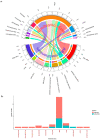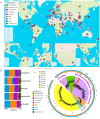Global Antimicrobial Resistance Gene Study of Helicobacter pylori: Comparison of Detection Tools, ARG and Efflux Pump Gene Analysis, Worldwide Epidemiological Distribution, and Information Related to the Antimicrobial-Resistant Phenotype
- PMID: 37508214
- PMCID: PMC10376887
- DOI: 10.3390/antibiotics12071118
Global Antimicrobial Resistance Gene Study of Helicobacter pylori: Comparison of Detection Tools, ARG and Efflux Pump Gene Analysis, Worldwide Epidemiological Distribution, and Information Related to the Antimicrobial-Resistant Phenotype
Abstract
We conducted a global-scale study to identify H. pylori antimicrobial-resistant genes (ARG), address their global distribution, and understand their effect on the antimicrobial resistance (AMR) phenotypes of the clinical isolates. We identified ARG using several well-known tools against extensive bacterial ARG databases, then analyzed their correlation with clinical antibiogram data from dozens of patients across countries. This revealed that combining multiple tools and databases, followed by manual selection of ARG from the annotation results, produces more conclusive results than using a single tool or database alone. After curation, the results showed that H. pylori has 42 ARG against 11 different antibiotic classes (16 genes related to single antibiotic class resistance and 26 genes related to multidrug resistance). Further analysis revealed that H. pylori naturally harbors ARG in the core genome, called the 'Set of ARG commonly found in the Core Genome of H. pylori (ARG-CORE)', while ARG-ACC-the ARG in the accessory genome-are exclusive to particular strains. In addition, we detected 29 genes of potential efflux pump-related AMR that were mostly categorized as ARG-CORE. The ARG distribution appears to be almost similar either by geographical or H. pylori populations perspective; however, some ARG had a unique distribution since they tend to be found only in a particular region or population. Finally, we demonstrated that the presence of ARG may not directly correlate with the sensitive/resistance phenotype of clinical patient isolates but may influence the minimum inhibitory concentration phenotype.
Keywords: Helicobacter pylori; antimicrobial resistance (AMR); antimicrobial-resistant gene (ARG); clinical implications; genome analysis; global distribution.
Conflict of interest statement
The authors declare no conflict of interest.
Figures




Similar articles
-
Exploration of the molecular mechanisms underlying the antibiotic resistance of Helicobacter pylori: A whole-genome sequencing-based study in Southern China.Helicobacter. 2022 Apr;27(2):e12879. doi: 10.1111/hel.12879. Epub 2022 Feb 6. Helicobacter. 2022. PMID: 35124867
-
Antimicrobial susceptibility and clarithromycin resistance patterns of Helicobacter pylori clinical isolates in Vietnam.F1000Res. 2016 Apr 13;5:671. doi: 10.12688/f1000research.8239.1. eCollection 2016. F1000Res. 2016. PMID: 27583131 Free PMC article.
-
Broad spectrum resistance in Helicobacter pylori isolated from gastric biopsies of patients with dyspepsia in Cameroon and efflux-mediated multiresistance detection in MDR isolates.BMC Infect Dis. 2019 Oct 22;19(1):880. doi: 10.1186/s12879-019-4536-8. BMC Infect Dis. 2019. PMID: 31640588 Free PMC article.
-
Helicobacter pylori antimicrobial resistance in Melbourne, Australia. Time to review therapeutic guidelines?Intern Med J. 2021 Nov;51(11):1919-1926. doi: 10.1111/imj.15355. Intern Med J. 2021. PMID: 33977647 Review.
-
The Emergence of Multidrug-Resistant Helicobacter pylori in Southeast Asia: A Systematic Review on the Trends and Intervention Strategies Using Antimicrobial Peptides.Antibiotics (Basel). 2021 Sep 1;10(9):1061. doi: 10.3390/antibiotics10091061. Antibiotics (Basel). 2021. PMID: 34572643 Free PMC article. Review.
Cited by
-
Antibiotic resistance in Helicobacter pylori: a genetic and physiological perspective.Gut Pathog. 2025 May 23;17(1):35. doi: 10.1186/s13099-025-00704-5. Gut Pathog. 2025. PMID: 40410811 Free PMC article. Review.
-
Novel Drug-like HsrA Inhibitors Exhibit Potent Narrow-Spectrum Antimicrobial Activities against Helicobacter pylori.Int J Mol Sci. 2024 Sep 22;25(18):10175. doi: 10.3390/ijms251810175. Int J Mol Sci. 2024. PMID: 39337660 Free PMC article.
-
The Role of Probiotics in the Eradication of Helicobacter pylori and Overall Impact on Management of Peptic Ulcer: A Study Involving Patients Undergoing Triple Therapy in Bangladesh.Cureus. 2024 Mar 16;16(3):e56283. doi: 10.7759/cureus.56283. eCollection 2024 Mar. Cureus. 2024. PMID: 38495972 Free PMC article.
-
Genomic insights into the antimicrobial resistance and virulence of Helicobacter pylori isolates from gastritis patients in Pereira, Colombia.BMC Genomics. 2024 Sep 9;25(1):843. doi: 10.1186/s12864-024-10749-6. BMC Genomics. 2024. PMID: 39251950 Free PMC article.
-
Global prevalence of Helicobacter pylori antibiotic resistance among children in the world health organization regions between 2000 and 2023: a systematic review and meta-analysis.BMC Med. 2024 Dec 23;22(1):598. doi: 10.1186/s12916-024-03816-y. BMC Med. 2024. PMID: 39710669 Free PMC article.
References
-
- Alexander S.M., Retnakumar R.J., Chouhan D., Devi T.N.B., Dharmaseelan S., Devadas K., Thapa N., Tamang J.P., Lamtha S.C., Chattopadhyay S. Helicobacter pylori in Human Stomach: The Inconsistencies in Clinical Outcomes and the Probable Causes. Front. Microbiol. 2021;12:713955. doi: 10.3389/fmicb.2021.713955. - DOI - PMC - PubMed
-
- Hooi J.K.Y., Lai W.Y., Ng W.K., Suen M.M.Y., Underwood F.E., Tanyingoh D., Malfertheiner P., Graham D.Y., Wong V.W.S., Wu J.C.Y., et al. Global Prevalence of Helicobacter pylori Infection: Systematic Review and Meta-Analysis. Gastroenterology. 2017;153:420–429. doi: 10.1053/j.gastro.2017.04.022. - DOI - PubMed
-
- Alfaray R.I., Saruuljavkhlan B., Ansari S., Fauzia K.A., Yamaoka Y. Review: Epidemiology of Helicobacter pylori Infection. Microbiota Health Dis. 2022;4:e733. doi: 10.26355/mhd_20229_733. - DOI
Grants and funding
LinkOut - more resources
Full Text Sources

